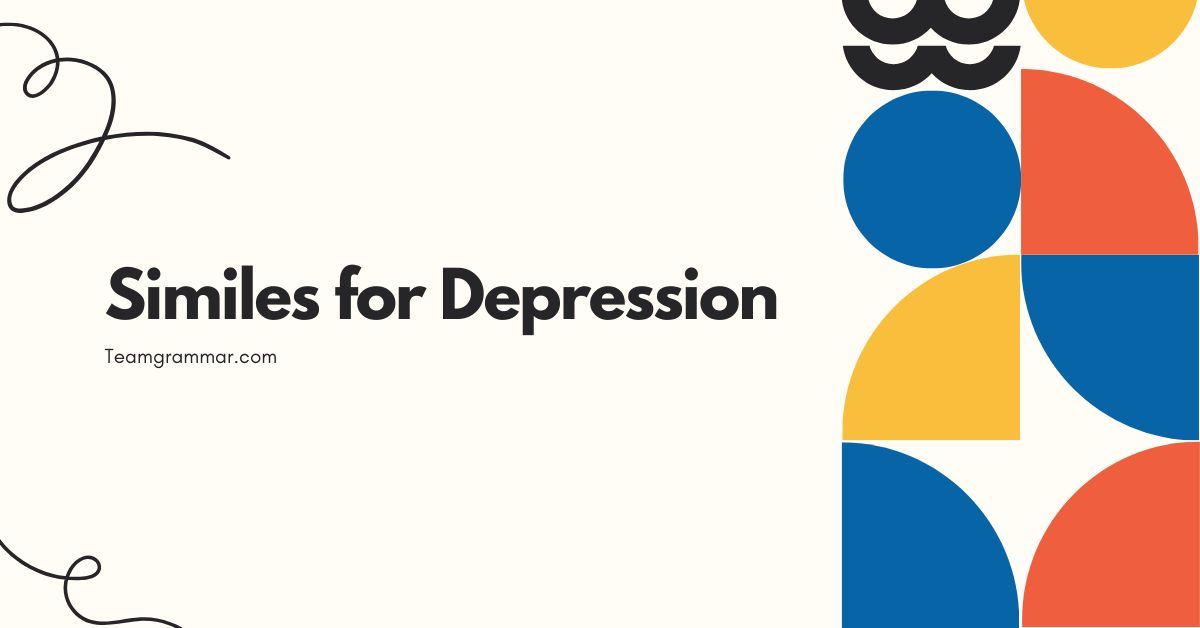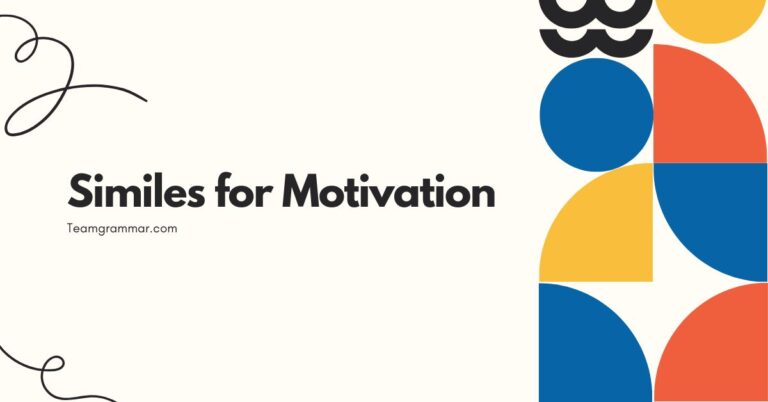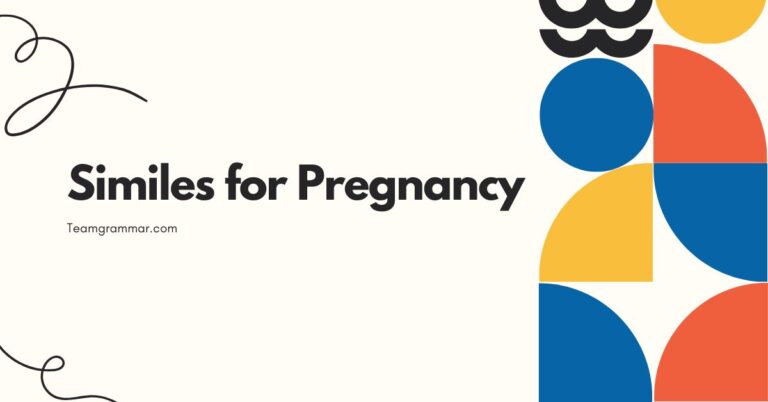35 Similes for Depression: Understanding and Expressing Feelings
Depression is a complex and deeply personal experience, often difficult to articulate. Similes, figures of speech that compare two unlike things using “like” or “as,” can provide a powerful tool for expressing the nuances of this condition.
Understanding how similes function and how they can be used to describe depression enhances both our ability to empathize with others and to articulate our own feelings. This article explores the use of similes in the context of depression, providing examples, usage rules, and practice exercises.
It is designed for students, writers, mental health professionals, and anyone seeking a deeper understanding of how language can illuminate the experience of depression.
Table of Contents
- Introduction
- Definition of Simile
- Structural Breakdown of Similes
- Types of Similes
- Examples of Similes for Depression
- Usage Rules for Similes
- Common Mistakes When Using Similes
- Practice Exercises
- Advanced Topics in Similes
- Frequently Asked Questions
- Conclusion
Introduction
Depression is a pervasive and often debilitating mental health condition affecting millions worldwide. Its symptoms can range from persistent sadness and loss of interest to physical ailments and cognitive difficulties.
Expressing the internal experience of depression can be challenging, as its impact is often deeply personal and subjective. Similes offer a unique avenue for conveying the intangible aspects of depression, allowing individuals to connect with and understand this condition more effectively.
This article aims to provide a comprehensive guide to using similes to articulate the complexities of depression, fostering empathy and promoting clearer communication.
By exploring the structure, types, and usage rules of similes, this article equips readers with the tools to craft powerful and evocative descriptions of depression. Through numerous examples, practice exercises, and discussions of common mistakes, learners will gain confidence in their ability to use similes effectively.
Whether you are a student, writer, mental health professional, or simply someone seeking to better understand depression, this article offers valuable insights into the art of expressing complex emotions through figurative language. Understanding similes and their proper usage can make a significant difference in how we communicate and understand the experience of depression.
Definition of Simile
A simile is a figure of speech that directly compares two different things using the words “like” or “as.” The purpose of a simile is to create a vivid image or enhance understanding by drawing a parallel between something familiar and something less known. Similes are a type of figurative language, meaning they use words or expressions with a meaning that is different from the literal interpretation.
In the context of grammar, similes are important because they demonstrate the flexibility and expressive power of language. They are used to enrich writing and speech, making it more engaging and memorable.
Similes fall under the broader category of tropes, which are figures of speech that alter the usual meaning of words. They are commonly used in literature, poetry, and everyday conversation to add depth and color to communication.
Classification of Similes
Similes are classified as a type offigure of speech, specifically a trope. They belong to a group of figurative language devices that also includes metaphors, analogies, and personification.
The key distinction between a simile and a metaphor is the use of “like” or “as” in a simile, whereas a metaphor directly equates two things without using these words.
For example:
- Simile: “Her sadness was like a heavy cloak.”
- Metaphor: “Her sadness was a heavy cloak.”
Similes can also be categorized based on the type of comparison they make. They can be used to compare physical attributes, emotional states, or abstract concepts.
The effectiveness of a simile depends on the clarity and relevance of the comparison.
Function of Similes
The primary function of a simile is toenhance understanding and create a vivid imagein the reader’s or listener’s mind. By comparing something unfamiliar to something familiar, similes can make abstract concepts more concrete and easier to grasp.
In the context of depression, similes can help to express the intangible feelings and experiences associated with the condition.
Similes also serve anemotional function. They can evoke empathy and understanding by allowing others to relate to the speaker’s or writer’s feelings.
By using a simile, an individual can convey the intensity and nature of their emotions in a way that resonates with others. This can be particularly helpful in communicating the often-misunderstood experience of depression.
Contexts for Using Similes
Similes are used in a wide range of contexts, including:
- Literature: To add depth and imagery to stories, poems, and plays.
- Poetry: To create evocative and emotional expressions.
- Everyday Conversation: To add color and clarity to communication.
- Mental Health: To express and understand complex emotional states like depression.
- Therapy: To help patients articulate their feelings and experiences.
In each of these contexts, the purpose of a simile is to enhance understanding and create a connection between the speaker or writer and the audience. The choice of simile depends on the specific context and the desired effect.
Structural Breakdown of Similes
Similes typically consist of three key components:
- The Subject: The thing being described.
- The Comparison Word: “Like” or “as.”
- The Object of Comparison: The thing to which the subject is being compared.
The basic formula for a simile is: Subject + Comparison Word + Object of Comparison.
For example, in the simile “Her sadness was like a dark cloud,” “her sadness” is the subject, “like” is the comparison word, and “a dark cloud” is the object of comparison. The effectiveness of a simile depends on the relationship between the subject and the object of comparison.
The more relevant and evocative the comparison, the more impactful the simile will be.
Common Patterns in Similes
Similes often follow specific patterns that make them easily recognizable and effective. Some common patterns include:
- Subject + is + like/as + Adjective + Noun: “His hope was like a fragile bird.”
- Subject + Verb + like/as + Adverb + Verb: “She moved through the day like a ghost wanders.”
- Subject + is + like/as + Noun + that + Verbs: “The silence was like a blanket that smothers all sound.”
These patterns provide a framework for creating similes, but they can be adapted and modified to suit the specific context and desired effect. The key is to ensure that the comparison is clear and meaningful.
Rules for Constructing Effective Similes
While similes are a form of creative expression, there are certain rules that can help to ensure their effectiveness:
- Clarity: The comparison should be clear and easy to understand. Avoid using obscure or overly complex language.
- Relevance: The object of comparison should be relevant to the subject. The comparison should highlight a meaningful similarity or connection.
- Originality: While clichés can be tempting, try to create original and fresh similes that capture the reader’s attention.
- Imagery: Use vivid and evocative language to create a strong mental image.
- Context: Consider the context in which the simile is being used. The simile should be appropriate for the tone and purpose of the writing or speech.
By following these rules, you can create similes that are both effective and impactful. Remember that the goal of a simile is to enhance understanding and create a connection with the audience.
Types of Similes
Similes can be categorized based on the type of comparison they make and their level of originality. Understanding these different types can help you to choose the most appropriate simile for a given context.
Literal vs. Figurative Similes
A literal simile compares two things that are actually similar in some way. For example, “The sky is as blue as the ocean” is a literal simile because both the sky and the ocean can be blue.
A figurative simile, on the other hand, compares two things that are not literally similar but share some abstract quality or characteristic. For example, “Her sadness was like a heavy cloak” is a figurative simile because sadness is not literally a cloak, but it can feel heavy and burdensome.
Figurative similes are generally more effective in expressing complex emotions like depression because they allow for a more nuanced and evocative comparison.
Cliche vs. Original Similes
A cliché simile is an overused and predictable comparison that has lost its impact. Examples of cliché similes include “as busy as a bee” and “as strong as an ox.” While cliché similes may be easy to understand, they lack originality and can make your writing or speech sound uninspired.
An original simile is a fresh and unexpected comparison that captures the reader’s attention and creates a vivid image. Original similes are more effective in conveying complex emotions like depression because they offer a unique and insightful perspective.
For example, instead of saying “He was as sad as a broken heart” (a cliché), you could say “His sadness was like a silent scream.” This original simile is more evocative and captures the intensity of the emotion.
Positive vs. Negative Similes
A positive simile makes a comparison that highlights a positive quality or characteristic. For example, “She was as radiant as the sun” is a positive simile.
A negative simile makes a comparison that highlights a negative quality or characteristic. In the context of depression, negative similes are more common because they are used to express the negative emotions and experiences associated with the condition.
For example, “His hope was like a flickering candle in the wind” is a negative simile because it suggests that his hope is fragile and easily extinguished.
Examples of Similes for Depression
The following tables provide a range of examples of similes that can be used to describe different aspects of depression. These examples are organized by category to help you understand how similes can be used to express specific emotions and experiences.
Similes for Sadness
Sadness is a core symptom of depression. Similes can help to convey the depth and intensity of this emotion.
The following table provides examples of similes that can be used to describe sadness.
| Simile | Explanation |
|---|---|
| Her sadness was like a heavy cloak, weighing her down. | The sadness is compared to a heavy cloak, emphasizing its burden. |
| His heart felt as heavy as a stone. | The feeling of heaviness is compared to a stone, highlighting the emotional weight. |
| The tears flowed like a river, unstoppable and unending. | The tears are compared to a river, emphasizing their continuous flow. |
| Her smile was as rare as a sunny day in winter. | The rarity of the smile is compared to a sunny day in winter, highlighting its infrequency. |
| His laughter sounded like a distant echo, faint and hollow. | The quality of laughter is compared to a distant echo, revealing emptiness. |
| She felt as though her soul was as grey as a stormy sea. | The feeling of sadness is compared to a stormy sea, emphasizing the turmoil. |
| The grief settled like a thick fog, obscuring everything. | The grief is compared to a fog, emphasizing its obscuring effect. |
| His spirit felt as crushed as a wilted flower. | The feeling of being crushed is compared to a wilted flower, highlighting the loss of vitality. |
| Her hope was as dim as a dying ember. | The dimness of hope is compared to a dying ember, emphasizing its fragility. |
| The pain lingered like a phantom limb, always present. | The persistence of pain is compared to a phantom limb, highlighting its constant presence. |
| She felt like a ship lost at sea, without a compass. | The feeling of being lost is compared to a ship without a compass, emphasizing the lack of direction. |
| His world seemed as bleak as a barren desert. | The bleakness of the world is compared to a barren desert, highlighting the emptiness. |
| Her joy had vanished like dew in the morning sun. | The disappearance of joy is compared to dew in the sun, emphasizing its transience. |
| He felt as empty as a hollow shell. | The feeling of emptiness is compared to a hollow shell, highlighting the lack of substance. |
| Her heart ached like a wound that never heals. | The persistence of the ache is compared to an unhealing wound, highlighting its chronic nature. |
| The silence was as deafening as a scream. | The intensity of the silence is compared to a scream, emphasizing its overwhelming presence. |
| She felt as fragile as a butterfly’s wing. | The feeling of fragility is compared to a butterfly’s wing, highlighting the vulnerability. |
| His smile was as fake as a plastic flower. | The insincerity of the smile is compared to a plastic flower, emphasizing its artificiality. |
| The memories haunted her like ghosts. | The haunting nature of the memories is compared to ghosts, highlighting their persistent presence. |
| She felt as though her life was like a broken record on repeat. | The repetitive nature of life is compared to a broken record, emphasizing the lack of change. |
| His tears were like acid, burning through his soul. | The pain of the tears is compared to acid, highlighting their destructive power. |
| She felt as small as an ant under a magnifying glass. | The feeling of insignificance is compared to an ant under a magnifying glass, emphasizing the feeling of being scrutinized. |
| His heart was as cold as ice. | The lack of emotion is compared to ice, highlighting the emotional coldness. |
| She felt like she was drowning in sorrow. | The overwhelming feeling of sorrow is compared to drowning, emphasizing its suffocating nature. |
Similes for Loss of Interest
A significant symptom of depression is the loss of interest or pleasure in activities that were once enjoyable. Similes can be used to describe this lack of motivation and enthusiasm.
The following table provides examples of similes that can be used to describe loss of interest.
| Simile | Explanation |
|---|---|
| His passion was like a fire that had burned out. | The lost passion is compared to a fire that has burned out, emphasizing its extinction. |
| Her hobbies felt as appealing as chores. | The lack of appeal is compared to chores, highlighting the feeling of obligation. |
| The world seemed as colorless as a black and white movie. | The lack of color is compared to a black and white movie, emphasizing the absence of vibrancy. |
| His energy had drained away like water from a leaky faucet. | The loss of energy is compared to water draining from a faucet, highlighting its gradual depletion. |
| The music sounded as dull as a monotone. | The lack of excitement is compared to a monotone, emphasizing the lack of variation. |
| Food tasted as bland as cardboard. | The lack of taste is compared to cardboard, emphasizing the absence of flavor. |
| His enthusiasm was like a deflated balloon. | The absence of enthusiasm is compared to a deflated balloon, emphasizing the loss of buoyancy. |
| Life felt as meaningless as a blank page. | The lack of meaning is compared to a blank page, highlighting the emptiness. |
| Her dreams seemed as distant as stars. | The unattainability of the dreams is compared to stars, emphasizing their remoteness. |
| The future looked as bleak as a cloudy day. | The lack of promise is compared to a cloudy day, highlighting the absence of light. |
| His motivation was as low as the tide. | The lack of motivation is compared to a low tide, emphasizing its ebb. |
| The joy had faded like a photograph. | The disappearance of joy is compared to a fading photograph, highlighting its gradual loss. |
| Everything felt as pointless as a broken pencil. | The lack of purpose is compared to a broken pencil, emphasizing the inability to function. |
| Her spark had gone out like a candle in the wind. | The extinguished spark is compared to a candle in the wind, highlighting its vulnerability. |
| His interest had waned like the moon. | The diminishing interest is compared to the waning moon, emphasizing its gradual decline. |
| The fun had evaporated like steam. | The disappearance of fun is compared to evaporating steam, highlighting its quick vanishing. |
| Her passion felt as dead as a doornail. | The deceased passion is compared to a doornail, emphasizing its finality. |
| His drive was as weak as a whisper. | The lack of drive is compared to a whisper, highlighting its feebleness. |
| The world seemed as muted as a silent film. | The lack of sound is compared to a silent film, emphasizing the absence of vibrancy. |
| His purpose was as clear as mud. | The lack of clarity is compared to mud, highlighting the confusion. |
| He felt as uninspired as a blank canvas. | The lack of inspiration is compared to a blank canvas, emphasizing the creative void. |
| Her enthusiasm was as flat as a pancake. | The lack of enthusiasm is compared to a flat pancake, highlighting the lack of excitement. |
| His dreams were as fragile as glass. | The vulnerability of the dreams is compared to glass, emphasizing their easiness to shatter. |
| She felt as if her get-up-and-go had got-up-and-went. | The loss of motivation is expressed with wordplay, emphasizing the complete absence of energy. |
| His ambition was as absent as a shadow at noon. | The lack of ambition is compared to a shadow at noon, highlighting its complete disappearance. |
Similes for Fatigue
Fatigue is another common symptom of depression. Similes can be used to describe the overwhelming sense of tiredness and lack of energy.
The following table provides examples of similes that can be used to describe fatigue.
| Simile | Explanation |
|---|---|
| His energy felt like a battery that had run dry. | The lack of energy is compared to a drained battery, emphasizing its depletion. |
| She moved as slowly as a snail. | The slowness of movement is compared to a snail, highlighting the lack of speed. |
| His body felt as heavy as lead. | The feeling of heaviness is compared to lead, emphasizing the physical burden. |
| Her limbs felt as weak as jelly. | The weakness of the limbs is compared to jelly, highlighting the lack of strength. |
| The fatigue was as relentless as a storm. | The persistence of the fatigue is compared to a storm, emphasizing its unyielding nature. |
| He felt as if he was wading through treacle. | The difficulty of movement is compared to wading through treacle, emphasizing the resistance. |
| Her mind felt as foggy as a winter morning. | The lack of clarity is compared to a foggy morning, emphasizing the mental haze. |
| His thoughts moved as sluggishly as molasses. | The slowness of the thoughts is compared to molasses, highlighting the lack of speed. |
| She felt as drained as a squeezed lemon. | The feeling of being drained is compared to a squeezed lemon, emphasizing the complete extraction of energy. |
| His sleep was as restless as a stormy night. | The lack of rest is compared to a stormy night, emphasizing the turbulence. |
| Her bones felt as brittle as glass. | The feeling of fragility is compared to glass, highlighting the vulnerability. |
| He felt as though he had the energy of a sloth. | The lack of energy is compared to a sloth, emphasizing the extreme slowness. |
| Her muscles felt as tight as coiled springs. | The tension in the muscles is compared to coiled springs, emphasizing the tightness. |
| His body felt as heavy as if he was carrying the world. | The feeling of burden is compared to carrying the world, emphasizing the immense weight. |
| She felt as listless as a leaf floating on a still pond. | The lack of energy is compared to a leaf on a pond, emphasizing the passivity. |
| His vitality had ebbed away like a receding tide. | The loss of vitality is compared to a receding tide, highlighting the gradual decline. |
| She felt as if her get-up-and-go had got-up-and-went. | The lack of motivation is expressed with wordplay, emphasizing the complete absence of energy. |
| His strength was as depleted as a well after a drought. | The depletion of strength is compared to a well after a drought, highlighting the scarcity. |
| She felt as limp as a rag doll. | The lack of muscle tone is compared to a rag doll, emphasizing the flaccidity. |
| His energy level was as low as the volume on a muted TV. | The low energy is compared to a muted TV, highlighting the lack of intensity. |
| She felt as if her blood was moving through her veins like sludge. | The slow movement is compared to sludge, emphasizing the sluggishness. |
| His thoughts were as heavy as stones in his mind. | The burden of thoughts is compared to stones, highlighting the mental weight. |
| She felt as though she was trying to run a marathon in slow motion. | The difficulty of activity is compared to a marathon in slow motion, emphasizing the struggle. |
| His sleep was as elusive as a dream. | The difficulty of sleep is compared to a dream, highlighting its fleeting nature. |
| She felt as if she were carrying an invisible weight on her shoulders. | The burden is compared to an invisible weight, emphasizing the unseen pressure. |
Usage Rules for Similes
To use similes effectively, it’s essential to follow certain usage rules. These rules ensure that your similes are clear, relevant, and impactful.
Clarity Rule
The comparison in a simile should beclear and easy to understand. Avoid using obscure or overly complex language that could confuse the reader.
The relationship between the subject and the object of comparison should be immediately apparent.
Example:
- Clear: “Her sadness was like a dark cloud.”
- Unclear: “Her sadness was like a quantum entanglement of existential angst.”
Relevance Rule
The object of comparison should berelevant to the subject. The comparison should highlight a meaningful similarity or connection.
Avoid making comparisons that are arbitrary or illogical.
Example:
- Relevant: “His hope was like a fragile bird.”
- Irrelevant: “His hope was like a refrigerator.”
Originality Rule
While clichés can be tempting, try to create original and fresh similes that capture the reader’s attention. Overused similes can make your writing or speech sound uninspired.
Example:
- Original: “Her sadness was like a silent scream.”
- Cliché: “He was as sad as a broken heart.”
Imagery Rule
Use vivid and evocative language to create a strong mental image. The simile should appeal to the senses and help the reader to visualize the comparison.
Example:
- Vivid: “The tears flowed like a river, unstoppable and unending.”
- Weak: “She cried a lot.”
Context Rule
Consider thecontextin which the simile is being used. The simile should be appropriate for the tone and purpose of the writing or speech.
Avoid using similes that are insensitive or inappropriate for the audience.
Example:
- Appropriate: “His energy felt like a battery that had run dry.” (in a discussion about fatigue)
- Inappropriate: “His energy felt like a bomb about to explode.” (in a calm conversation)
Common Mistakes When Using Similes
Even experienced writers can make mistakes when using similes. Being aware of these common errors can help you to avoid them and improve the effectiveness of your writing.
Using Clichés
Clichés are overused and predictable similes that have lost their impact. Avoid using clichés and instead strive to create original and fresh comparisons.
Example:
- Incorrect: “He was as busy as a bee.”
- Correct: “He was working as tirelessly as a machine.”
Mixing Metaphors and Similes
Mixing metaphors and similes can create confusing and illogical comparisons. Be sure to use either a simile or a metaphor, but not both at the same time.
Example:
- Incorrect: “Her sadness was like a heavy cloak that was a storm.”
- Correct: “Her sadness was like a heavy cloak.” (Simile)
- Correct: “Her sadness was a storm.” (Metaphor)
Using Illogical Comparisons
Illogical comparisons can confuse the reader and undermine the effectiveness of the simile. Make sure that the comparison is clear and relevant.
Example:
- Incorrect: “His hope was like a carrot.”
- Correct: “His hope was like a fragile bird.”
Overusing Similes
Overusing similes can make your writing sound contrived and repetitive. Use similes sparingly and only when they add value to your writing.
Example:
- Incorrect: “The day was like a dream. The sky was like a painting. The clouds were like cotton balls.”
- Correct: “The day was dreamlike, with a sky that resembled a painting.”
Practice Exercises
The following exercises will help you to practice using similes to describe depression. Each exercise includes a set of questions and answers to help you assess your understanding.
Exercise 1: Identifying Similes
Identify the similes in the following sentences:
| Question | Answer |
|---|---|
| 1. Her sadness was like a heavy cloak, weighing her down. | “like a heavy cloak” |
| 2. The tears flowed like a river, unstoppable and unending. | “like a river” |
| 3. His passion was like a fire that had burned out. | “like a fire” |
| 4. She moved as slowly as a snail. | “as a snail” |
| 5. Life felt as meaningless as a blank page. | “as a blank page” |
| 6. His heart felt as heavy as a stone. | “as heavy as a stone” |
| 7. The world seemed as colorless as a black and white movie. | “as colorless as a black and white movie” |
| 8. Her limbs felt as weak as jelly. | “as weak as jelly” |
| 9. His dreams seemed as distant as stars. | “as distant as stars” |
| 10. The fatigue was as relentless as a storm. | “as relentless as a storm” |
Exercise 2: Completing Similes
Complete the following similes with an appropriate object of comparison:
| Question | Answer |
|---|---|
| 1. His hope was like __________. | a fragile bird |
| 2. Her smile was as rare as __________. | a sunny day in winter |
| 3. The grief settled like __________. | a thick fog |
| 4. His energy had drained away like __________. | water from a leaky faucet |
| 5. Food tasted as bland as __________. | cardboard |
| 6. She felt as empty as __________. | a hollow shell |
| 7. The silence was as deafening as __________. | a scream |
| 8. His world seemed as bleak as __________. | a barren desert |
| 9. She felt as fragile as __________. | a butterfly’s wing |
| 10. His passion was like __________. | a fire that had burned out |
Exercise 3: Creating Original Similes
Create original similes to describe the following emotions:
| Emotion | Example Simile |
|---|---|
| Sadness | Her sadness was like a silent scream. |
| Loss of Interest | His enthusiasm was like a deflated balloon. |
| Fatigue | Her energy felt like a battery that had run dry. |
| Despair | His hope was like a flickering candle in the wind. |
| Anxiety | Her thoughts raced like a runaway train. |
Advanced Topics in Similes
For advanced learners, exploring more complex aspects of similes can enhance their understanding and usage of this figure of speech.
Extended Similes
Anextended simileis a simile that is developed over several lines or sentences. It provides a more detailed and nuanced comparison than a simple simile.
Extended similes are often used in literature and poetry to create
Frequently Asked Questions
Conclusion
Similes are a powerful tool for expressing the complexities of depression, offering a way to articulate intangible feelings and experiences in a relatable manner. By understanding the structure, types, and usage rules of similes, individuals can craft evocative descriptions that foster empathy and promote clearer communication.
This article has provided numerous examples, practice exercises, and discussions of common mistakes to equip learners with the skills to use similes effectively.
Whether you are a student, writer, mental health professional, or someone seeking to better understand depression, mastering the art of using similes can significantly enhance your ability to connect with and comprehend this condition. As you continue to explore the expressive power of language, remember that similes offer a unique avenue for illuminating the often-misunderstood experience of depression, fostering greater understanding and compassion.







